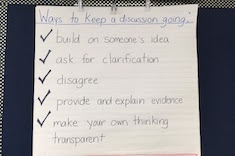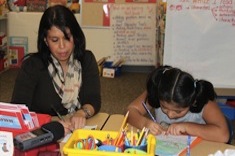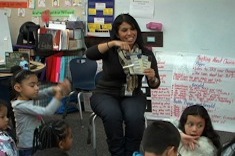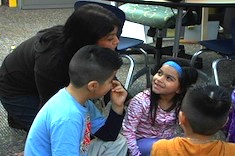Do you ever find yourself reading an email quickly to capture the gist of it and then putting it away in a folder, only to find yourself pulling it out again to reread and get the details you missed the first time? I do this all the time. Rereading is an integral part of my life as a reader. I allow myself to reread a text as many times as I need to to make sense of it. In fact, I consider it one of my rights as a reader, a learner, and a speaker of English as a foreign language. Every time I reread, I’m able to
- read closely and capture what I missed the first time I read the text;
- grasp language in a different way—through style, meaning, or word choice;
- remember more of the text; and
- think of the content in multiple layers.
When I think about the conditions I grant myself as a reader, I want to make sure I re-create them in my classroom for young readers as well. I often ask myself these questions to guide my thinking:
- Do I allow plenty of opportunities for rereading in my classroom?
- Am I rereading a favorite read aloud just for fun?
- Am I rereading favorite picture books and inviting students to purposefully listen from a different perspective each time?
- When introducing a new concept or skills, am I going back to those favorite picture books to use them as mentor texts?
- Have I been intentional and purposeful in introducing and teaching this reading strategy to my students?
I refer to these reflection questions often to keep myself in check and make sure I am serving students well, especially the English language learners in my class.
If the answer to any of these questions is no, then it’s time for me to take a look at my schedule and find possibilities and invitations within the established structure for more rereading.
Reading Workshop
Read-aloud time is a perfect opportunity to go back to some favorites. Most teachers understand the importance of multiple read alouds throughout the day. When we reread favorite read alouds to introduce new concepts in our minilessons, we are facilitating learning for our students by giving them one familiarity factor. Think of the effect that this strategy alone has on English language learners. Our students are already familiar with the language used in the book. They understand the plot. There is no surprise in the content. Now they are able to build one more layer of understanding because they are asked to think of it in a new way. This is where learning takes place.
Having a specific location for those read-aloud books after you have shared them with the children is a small but significant strategy. Placing them in a special basket or area sends the message to the children that they can reread these books anytime during independent reading. Now it becomes an open invitation, and as we know, children love choices. It also facilitates conversations during conferring because you can refer to these books with ease. Students know where they are, and if they need the inspiration or guidance from a mentor text, they know where to go.
Independent Reading
I often think of my English language learners and how I can support their language development throughout the day even if I am not there in the room as the English language specialist. Programs like GarageBand make recording stories a snap. It’s easy to use and navigate for both teacher and students. It takes only a short investment of my time, but the positive ripple effect is great. Recording favorite read-aloud or mentor texts so that students can access them during independent reading is one way we can encourage students to keep revisiting these stories as they discover new things each time.
Writing Workshop
It sounds obvious that students will be doing lots of rereading in writing workshops. But what if we establish a routine during writing workshop where the first 10 minutes is about rereading our work, discussing our writing with a friend, and thinking about revision before new writing follows? With these simple habits, we are teaching readers the importance of going back to our work over and over again. We are also teaching our students that conversations are one way to clarify our thinking and revise our thoughts. English language learners bloom in this kind of environment because it allows them to think through ideas thoroughly first. They are given the chance to rehearse the language they might use in their writing.
Multistep Directions in All Subjects
English language learners are acquiring language through four main modalities: speaking, reading, listening, and writing. However, regardless of how proficient they are with using the English language, all students can benefit from visually accessing written multistep directions. These allow all students to go back to the board or chart, reread the steps for any process, and follow them independently. We often underestimate the value of such a simple, concise way of processing information, especially for our English language learners.
Over time, the teachers I work with and I have discovered these small but practical revisions in our teaching to foster more rereading. They have had a powerful effect not just on English language learners but on all young readers and writers in our care. Perhaps you’ll even find yourself rereading this article as you think about making changes in your own instruction.









